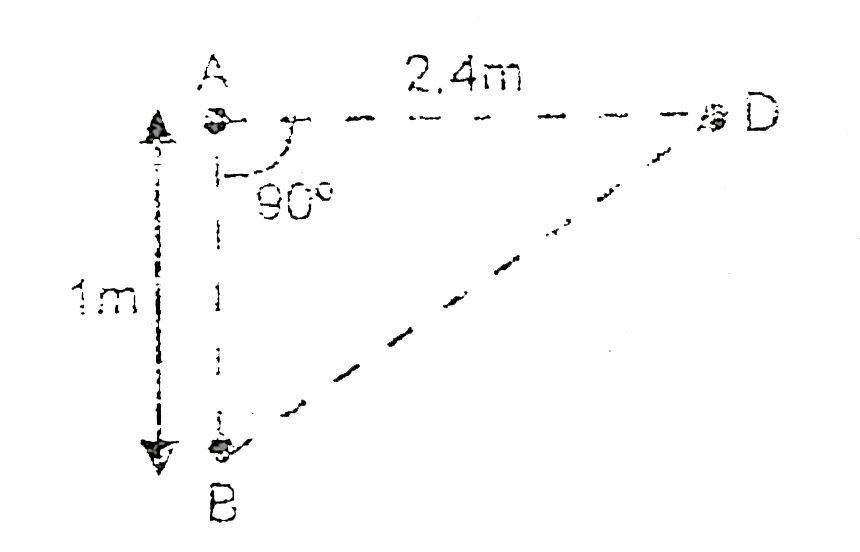The frequencies of two sound sources are 256 Hz and 260 Hz, At t=0 the intesinty of sound is maximum. Then the phase difference at the time t=1/16 sec will be
zero
π
π2
π4
The correct Answer is:C
To solve the problem, we need to determine the phase difference between two sound waves at a given time, given their frequencies. Here’s a step-by-step breakdown of the solution:
Step 1: Identify the frequencies
We have two sound sources with frequencies:
- f1=256Hz
- f2=260Hz
Step 2: Calculate the beat frequency
The beat frequency fb is calculated as the absolute difference between the two frequencies:
fb=|f1−f2|=|256−260|=4Hz
Step 3: Determine the frequency of temporal interference
The frequency of temporal interference f is half of the beat frequency:
f=fb2=42=2Hz
Step 4: Calculate the phase difference
The phase difference Δϕ at time t can be calculated using the formula:
Δϕ=2πft
Substituting the values:
- f=2Hz
- t=116s
We get:
Δϕ=2π×2×116
Δϕ=4π16=π4radians
Conclusion
Thus, the phase difference at t=116s is:
Δϕ=π4radians
We have two sound sources with frequencies:
- f1=256Hz
- f2=260Hz
The beat frequency fb is calculated as the absolute difference between the two frequencies:
fb=|f1−f2|=|256−260|=4Hz
The frequency of temporal interference f is half of the beat frequency:
f=fb2=42=2Hz
The phase difference Δϕ at time t can be calculated using the formula:
Δϕ=2πft
Substituting the values:
- f=2Hz
- t=116s
Δϕ=2π×2×116
Δϕ=4π16=π4radians
Thus, the phase difference at t=116s is:
Δϕ=π4radians
Similar Questions
If the frequencies of the sound second and fifth harmonics of a string differ by 54 Hz. What is the fundamental frequency of the string ?
View SolutionTwo point sound sources A and B each to power 25πw and frequency 850Hz are 1m apart. The sources are in phase

Determine the phase difference between the waves emitting from A and B received by detector D as shown in figure. Velocity of sound =340m/s.
View SolutionThe frequency of a source of sound is 100Hz. How many times does it vibrate in a minute ?
View SolutionA stationary source emits the sound of frequency f0=492 Hz. The sound is reflected by a large car approaching the source with a speed of 2ms−1. The reflected signal is received by the source and superposed with the original. What will be the beat frequency of the resulting signal in Hz? (Given that the speed of sound in air is 330ms−1 and the car reflects the sound at the frequency it has received).
View SolutionThe frequency of sound produced by a bell is 500 Hz the velocity of the source relative to still air is 60 m/s. An observer moves at 30 m/s along the same line as the source. Calculate the frequency of sound wave measured by the observer. Consider all possible cases (speed of sound v=340ms.)
View SolutionThe frequency of sound produced by a bell is 500 Hz the velocity of the source relative to still air is 60 m/s. An observer moves at 30 m/s along the same line as the source. Calculate the frequency of sound wave measured by the observer. Consider all possible cases (speed of sound v=340ms.)
View SolutionTwo sounds of very close frequencies, say 256 Hz and 260 Hz are produced simultaneously. What is the frequency of resultant sound and also write the number of beats heard in one second?
View SolutionA source emits a sound of frequency of 400 Hz , but the listener hears it to be 390 Hz . Then
View SolutionIf a sound wave of frequency 500 Hz and velocity 350 m/s. Then the distance between the two particles of a phase difference of 60∘ will be nearly
View SolutionA source of sound of frequency 500 Hz is moving towards an observer with velocity 30 m/s . The speed of sound is 330 m/s . the frequency heard by the observer will be
View Solution
